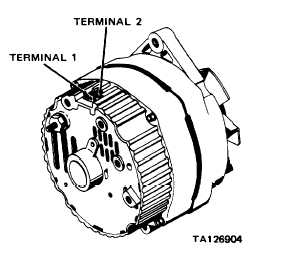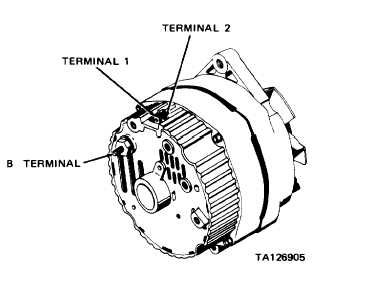| |
TM 10-3930-638-24&P
2-22. CHARGING SYSTEM TROUBLESHOOTING (cont)
MALFUNCTION
TEST OR INSPECTION
CORRECTIVE ACTION
1. ABNORMAL ALTERNATOR LIGHT OPERATION (cont)
STEP 1. (cont)
b. If ALTERNATOR light is on, grasp and pull
connector from alternator terminals 1 and 2.
If the ALTERNATOR light goes out, replace
the alternator (para 2-26).
If the light stays on, check for a short between
these wires, then install connector on
alternator terminals 1 and 2.
Step 2. Place IGNITION switch to ON with engine stopped. ALTERNATOR light should be on.
With engine running, ALTERNATOR light should be off.
a. If ALTERNATOR light is off with engine stopped, or on with engine running, check for an open
circuit between alternator terminal l and ALTERNATOR light. Use an ohmmeter to check
diode and 40 ohm resistor in ALTERNATOR light circuit.
b. If circuit tests are satisfactory, troubleshoot alternator (MALFUNCTION 2 below).
2. ALTERNATOR OUTPUT LOW, UNSTEADY OR ZERO
Step 1.
Turn IGNITION switch to ON and alternately connect voltmeter leads from ground to alternator
terminal 1, terminal 2 and B terminal.
a. If voltmeter indicates 24 Vdc at
all three terminals, proceed to
step 2.
b. If voltmeter does not indicate
24 Vdc at one or more terminals,
check for an open circuit
between battery positive post
and affected alternator
terminal.
Step 2. Disconnect battery ground cable and
connect an ammeter between
alternator B terminal and starter
relay terminal 3.
Reconnect battery ground cable, and
connect a carbon pile across batteries.
Turn all vehicle lights on to increase
load on batteries, and operate engine
at 1800 rpm.
a. If ammeter indicates 27 to 47 amperes, but ALTERNATOR light stays on, check for open
circuit from alternator terminal 1 in wiring, diode, and 40 ohm resistor.
b. If ammeter does not indicate 27 to 47 amperes, replace alternator (para 2-26).
2-104
|



